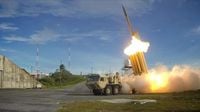The Pentagon is sounding the alarm over the rapid depletion of U.S. missile stockpiles as it seeks more than $3.5 billion in emergency funding to replace high-tech interceptors expended in the defense of Israel since late 2023. According to Bloomberg, this urgent request, detailed in budget documents prepared through mid-May 2025, underscores the mounting costs of America’s military presence in the Middle East and the growing concerns about whether U.S. production lines can keep up with surging demand.
The bulk of the funds would go toward replenishing munitions used during recent operations, including at least $1 billion earmarked for Standard Missile-3 (SM-3) interceptors manufactured by RTX Corporation (formerly Raytheon Technologies). Additional millions are slated for radar maintenance, vessel refurbishment, and the transport of arms—routine but essential tasks that have become increasingly urgent as U.S. inventories dwindle. Nearly every line item in the Pentagon’s request is categorized as an emergency budget need, reflecting the severity of the situation.
This funding push draws on the 2024 Israeli Security Supplemental Appropriations Act, which allocated $14 billion, in part to rebuild U.S. stockpiles and bolster Israel’s missile defense capabilities. Pentagon filings describe the requests as necessary to offset costs borne by U.S. Central Command during operations conducted "at the request of or in coordination with Israel" in response to Iranian attacks and threats from proxy groups.
The urgency behind these requests is rooted in a string of dramatic events that began in October 2023, shortly after the Hamas attack on Israel. The most significant spike occurred on April 13, 2024, when Iran launched more than 300 missiles and drones directly at Israel. The vast majority were intercepted by the combined efforts of Israeli, U.S., and allied air defense systems. U.S. Navy guided-missile destroyers USS Arleigh Burke and USS The Sullivans, positioned in the Eastern Mediterranean, fired RIM-161 SM-3 surface-to-air missiles in defense of Israel, while U.S. Army units deployed Terminal High Altitude Area Defense (THAAD) interceptors. According to Bloomberg, these actions were coordinated closely with Israeli defense forces and came at a significant cost to American munitions reserves.
Admiral James Kilby, the acting chief of naval operations, addressed the issue head-on during a Senate Appropriations Committee hearing on August 19, 2025. When asked by Sen. Brian Schatz of Hawaii whether the Navy had enough SM-3 interceptors to handle global threats beyond the Middle East, Kilby responded, "We are, to your point, using them at an alarming rate. As you know, those are missiles procured by the Missile Defense Agency and then delivered to the Navy for our use. And we are using them quite effectively in the defense of Israel."
The SM-3 is a unique asset in the Navy’s arsenal, capable of engaging targets in space and coming in multiple variants, with costs ranging from $10 million to nearly $30 million per missile, according to the Missile Defense Agency. The newest versions are produced by RTX and Mitsubishi Heavy Industries. The Navy first used the SM-3 in combat during the April 2024 Iranian missile and drone attack, and again in October 2024, when Iran launched over 180 ballistic missiles at Israel. Navy warships in the eastern Mediterranean have since repeatedly launched these interceptors to shield Israel from further Iranian aggression, as reported by Business Insider.
But this high operational tempo is taking a toll. Analysts have raised concerns that the rapid expenditure of SM-3 interceptors in the Middle East could undermine U.S. readiness for other potential conflicts, particularly in the Pacific, where adversaries like China possess large arsenals of ballistic missiles. The fiscal year 2025 defense budget initially proposed slashing procurement of SM-3 Block IB interceptors from about 150 to zero over the next five years, with only a dozen of the newer Block IIA variants slated for annual production. Congress partially reversed these cuts, providing additional funding for more SM-3 production. In May 2025, the Pentagon awarded a substantial contract to RTX for dozens of SM-3 IB missiles, signaling a renewed emphasis on missile defense.
The Pentagon’s emergency request also includes $204 million for Lockheed Martin’s THAAD interceptors and $9.2 million for maintenance on the THAAD system’s TPY-2 radar, following unexpected engine and alternator replacements. During the June 2025 escalation between Israel and Iran, American forces fired more than 100 THAAD interceptors—roughly a quarter of the system’s operational inventory. Production, however, has struggled to keep pace: only 11 new THAAD interceptors were produced in 2024, with 12 expected in 2025.
Despite the best efforts of U.S. and allied forces, not every threat was neutralized. While many of Iran’s missiles and drones were intercepted, several still managed to strike Israeli targets, highlighting both the effectiveness and the limitations of current missile defense systems. The emergency requests from the Pentagon are separate from the approximately $4.2 billion in weapons and equipment already delivered to Israel between October 2023 and May 2024. Instead, the new funding is intended to cover costs incurred by U.S. Central Command during operations conducted "at Israel’s request or in coordination with Israel" to defend its territory, personnel, or assets.
Looking forward, the Pentagon’s 2026 budget plans include purchasing 37 new THAAD interceptors and investing billions to expand production capacity and strengthen the supply chain. Still, officials acknowledge that the heavy U.S. commitment to Israel has come at a cost to American readiness. As one former senior officer told Bloomberg, "The stockpiles are running low. We need more — and fast."
Some lawmakers and analysts worry that if the current pace of missile expenditure continues, the U.S. could find itself short-handed in the event of another major conflict elsewhere. Navy leadership has previously stressed the need for a robust inventory of SM-3s to counter high-end threats in the Pacific, but the demands of the Middle East have forced difficult trade-offs.
For now, the Pentagon’s emergency funding request stands as a stark reminder of the real costs—financial and strategic—of America’s ongoing defense commitments in an increasingly volatile world. Whether Congress will respond swiftly enough to replenish these critical stockpiles remains to be seen, but the urgency is clear: as global threats multiply, the United States can ill afford to let its missile defenses fall behind.




